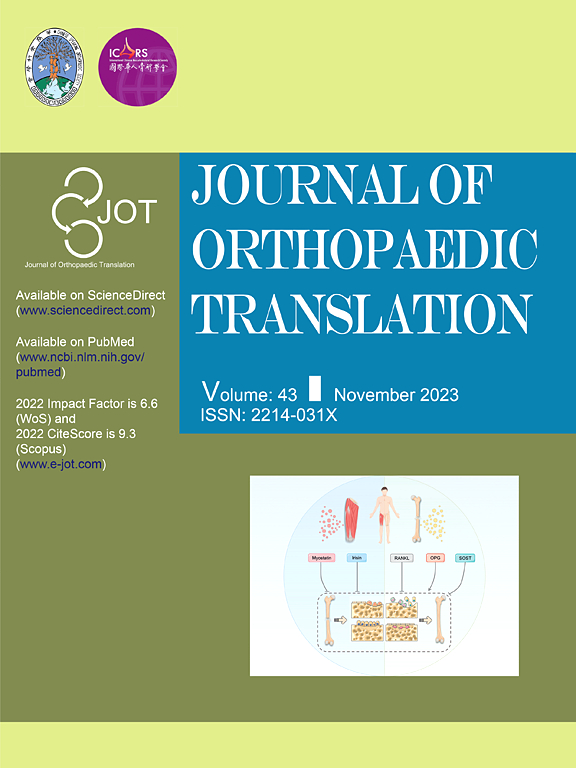Relieving oxidative stress microenvironment and promoting vascularized bone formation to treat femoral head necrosis using 3D-printed scaffold with ultralong-term multienzyme-like activity
IF 5.9
1区 医学
Q1 ORTHOPEDICS
引用次数: 0
Abstract
Background
Characterized by microcirculatory disorder and oxidative stress microenvironment, the repair of bone defect after hip preservation therapy (such as core decompression) for osteonecrosis of the femoral head (ONFH) remains a clinical challenge. Thus, an ideal bone scaffold for treating ONFH should not only promote bone and vessel formation but also alleviate hypoxia and oxidative stress.
Method
We integrated manganese oxides (MnOx) nanoparticles (NPs) with a 3D-printed poly(lactic-co-glycolic acid) (PLGA) scaffold to achieve this goal. The MnOx NPs were synthesized using an oxidation reaction and the scaffold was 3D-printed using a fused deposition modeling method. The characterization and the enzyme-like activity of the scaffold was investigated. The biocompatibility and biofunctions of the scaffold were evaluated both in vitro and in vivo, including the antioxidant capacity, the effects on promoting bone formation and vascularization, and the therapeutic effect in animal model.
Results
The resultant MnOx-doped PLGA scaffold could catalyze reactive oxygen species into oxygen through its superoxide dismutase (SOD)-like and catalase (CAT)-like activities. In vitro studies revealed that this multienzyme-like activity of the scaffold could be maintained for more than 30 days, thereby improving cell viability under oxidative stress. The underlying mechanism was shown to involve regulation of the antioxidant activity of cells via PI3K/AKT signaling pathway. The scaffold also significantly improved capabilities of osteogenesis and angiogenesis compared to pure PLGA scaffold. In vivo studies further demonstrated that the combination therapy of core decompression and scaffold implantation efficiently reduced osteoblast necrosis and enhanced vascularized bone formation in a clinically relevant ONFH rabbit model.
Conclusion
The 3D-printed MnOx-doped PLGA scaffold not only relieve oxidative stress to protect osteocytes under ONFH microenvironment but also promote vascularized bone formation, showing the potential for treating ONFH.
Translational potential of this article
PLGA has been already applied in clinical bone implants. Mn is an essential trace element for the human body and MnOx NPs offer the advantage of biocompatibility, ease of large-scale preparation, and low cost. Hence, this scaffold has the potential for clinical translation in the treatment of ONFH.

利用超长期多酶样活性3d打印支架缓解氧化应激微环境,促进血管化骨形成治疗股骨头坏死
背景股骨头坏死(ONFH)以微循环障碍和氧化应激微环境为特征,髋部保留治疗(如核心减压)后骨缺损的修复仍然是一个临床挑战。因此,治疗ONFH的理想骨支架不仅要促进骨和血管的形成,而且要减轻缺氧和氧化应激。方法将锰氧化物(MnOx)纳米颗粒(NPs)与3d打印聚乳酸-羟基乙酸(PLGA)支架相结合来实现这一目标。使用氧化反应合成MnOx NPs,并使用熔融沉积建模方法对支架进行3d打印。研究了支架的表征和酶样活性。体外和体内对支架的生物相容性和生物功能进行了评价,包括抗氧化能力、促进骨形成和血管形成的作用以及动物模型的治疗效果。结果制备的mnox掺杂PLGA支架可通过其超氧化物歧化酶(SOD)样和过氧化氢酶(CAT)样活性将活性氧催化成氧。体外研究表明,支架的这种多酶样活性可以维持30天以上,从而提高氧化应激下的细胞活力。潜在的机制被证明是通过PI3K/AKT信号通路调节细胞的抗氧化活性。与纯PLGA支架相比,该支架也显著提高了成骨和血管生成能力。体内研究进一步表明,在临床相关的ONFH兔模型中,核心减压和支架植入联合治疗有效地减少了成骨细胞坏死,增强了血管化骨形成。结论3d打印mnox掺杂PLGA支架不仅可以缓解ONFH微环境下的氧化应激,保护骨细胞,还可以促进血管化骨的形成,具有治疗ONFH的潜力。plga已在临床骨种植体中得到应用。Mn是人体必需的微量元素,MnOx NPs具有生物相容性好、易于大规模制备、成本低等优点。因此,这种支架在治疗ONFH方面具有临床转化的潜力。
本文章由计算机程序翻译,如有差异,请以英文原文为准。
求助全文
约1分钟内获得全文
求助全文
来源期刊

Journal of Orthopaedic Translation
Medicine-Orthopedics and Sports Medicine
CiteScore
11.80
自引率
13.60%
发文量
91
审稿时长
29 days
期刊介绍:
The Journal of Orthopaedic Translation (JOT) is the official peer-reviewed, open access journal of the Chinese Speaking Orthopaedic Society (CSOS) and the International Chinese Musculoskeletal Research Society (ICMRS). It is published quarterly, in January, April, July and October, by Elsevier.
 求助内容:
求助内容: 应助结果提醒方式:
应助结果提醒方式:


